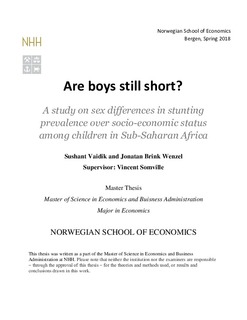Are boys still short? : a study on sex differences in stunting prevalence over socio-economic status among children in Sub-Saharan Africa
Master thesis
Permanent lenke
http://hdl.handle.net/11250/2560028Utgivelsesdato
2018Metadata
Vis full innførselSamlinger
- Master Thesis [4372]
Sammendrag
Background: Over 150 million children worldwide are stunted. In Sub-Saharan Africa alone
more than 1 in every 3 children is stunted due to insufficient food intake, boys being the most
vulnerable according to prior research. Although UN has accentuated the negative impact of
stunting and included it as part of the Sustainable Development Goal #2 ―End hunger‖, the
decline in stunting prevalence is slow partly due to the poverty trap cycle of stunting. The
economic costs of stunting are considerable as it precludes economic growth, which is especially
damaging for developing countries where stunting prevalence is substantial, resulting in
reinforcement of inequality.
Objective: The aim of this thesis is to explore possible determinants of nutritional status and
examine if the main significant variables identified can explain the gender gap of stunting
prevalence, both current status and development over time, in Sub-Saharan Africa.
Method: Student t-test and multiple logistic regression were employed to test for determinants of
nutritional status, the existence of sex differences in stunting and how that differed controlling for
socio-economic status proxied by several independent variables. Demographic and Health
surveys from 35 Sub-Saharan African countries conducted between 1986 and 2016 provided data
for the analysis.
Results: The pooled results display that boys are 1.18 times more likely to become stunted than
girls. Country specific results confirms the gender difference is in 33 of 35 countries (OR > 1,
95% CI) indicating a higher risk for boys. We found that wealth, mother’s education, polygamous
households, mother’s age at first birth are important factors in determining children’s nutritional
status. Although the observed determinants have significant impact, none of the tested variables
can explain the gender gap in stunting prevalence.
Conclusion: Our study confirms the gender gap indicated by smaller scale studies and hereby sets
an updated benchmark for the region. The study did not find that the exposed moderating factors
are playing a significant role in explaining the gender difference in stunting prevalence. Future
research should therefore focus on investigating new potential explanations for the gender gap.
